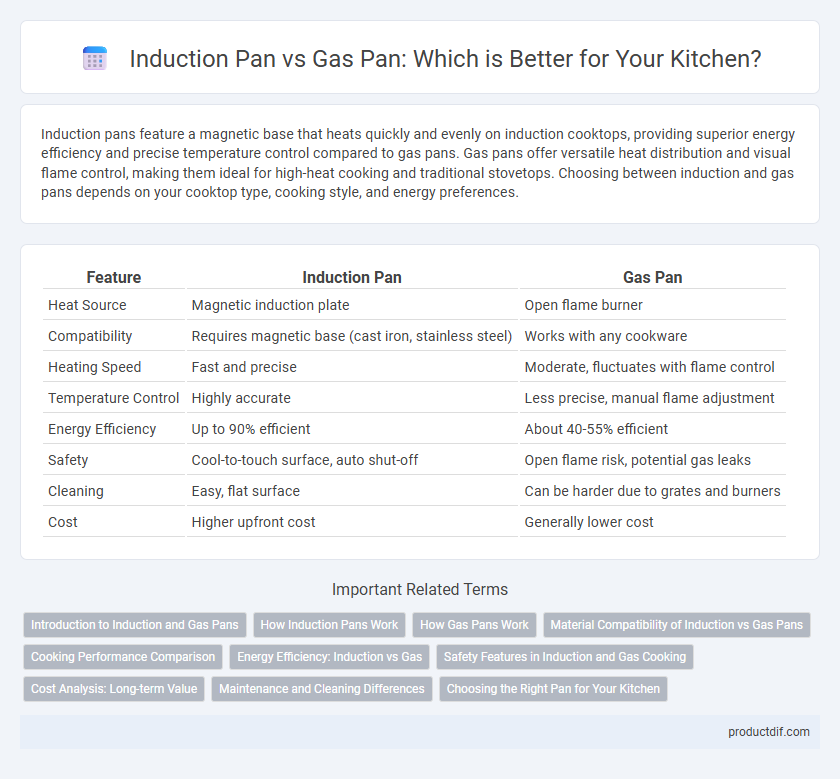Induction pans feature a magnetic base that heats quickly and evenly on induction cooktops, providing superior energy efficiency and precise temperature control compared to gas pans. Gas pans offer versatile heat distribution and visual flame control, making them ideal for high-heat cooking and traditional stovetops. Choosing between induction and gas pans depends on your cooktop type, cooking style, and energy preferences.
Table of Comparison
| Feature | Induction Pan | Gas Pan |
|---|---|---|
| Heat Source | Magnetic induction plate | Open flame burner |
| Compatibility | Requires magnetic base (cast iron, stainless steel) | Works with any cookware |
| Heating Speed | Fast and precise | Moderate, fluctuates with flame control |
| Temperature Control | Highly accurate | Less precise, manual flame adjustment |
| Energy Efficiency | Up to 90% efficient | About 40-55% efficient |
| Safety | Cool-to-touch surface, auto shut-off | Open flame risk, potential gas leaks |
| Cleaning | Easy, flat surface | Can be harder due to grates and burners |
| Cost | Higher upfront cost | Generally lower cost |
Introduction to Induction and Gas Pans
Induction pans feature a magnetic base designed to work with induction cooktops, generating heat directly within the pan for efficient and precise cooking. Gas pans are compatible with traditional gas stoves, using an open flame that provides instant heat adjustment and wide temperature control. Both types offer unique benefits, with induction pans excelling in energy efficiency and safety, while gas pans deliver versatile cooking performance.
How Induction Pans Work
Induction pans work by using electromagnetic fields to directly heat the cookware, making them compatible only with ferrous metal bases like cast iron or stainless steel. This method delivers faster, more efficient heating compared to traditional gas pans, which rely on an open flame to heat the bottom surface. The precise temperature control and energy conservation offered by induction cooking enhance the cooking experience and reduce energy waste.
How Gas Pans Work
Gas pans work by transferring heat through an open flame generated by burning natural gas or propane directly underneath the cookware, providing instant and adjustable heat control. The flame creates convection currents that evenly distribute heat across the pan's surface, enabling precise temperature regulation ideal for sauteing and searing. Unlike induction pans, gas pans require cookware made from materials like stainless steel, cast iron, or aluminum that can withstand direct flame and conduct heat efficiently.
Material Compatibility of Induction vs Gas Pans
Induction pans require ferromagnetic materials like cast iron or magnetic stainless steel to generate heat through electromagnetic fields, while gas pans can be made from a wider range of materials including aluminum, copper, and non-magnetic stainless steel. The material compatibility of induction pans ensures efficient heat transfer and even cooking, whereas gas pans rely on direct flame heating that accommodates diverse materials but may result in uneven heat distribution. Choosing the right pan material is crucial for optimizing cooking performance on induction cooktops and gas stoves.
Cooking Performance Comparison
Induction pans heat faster and distribute heat more evenly due to electromagnetic technology, leading to precise temperature control and energy efficiency. Gas pans offer immediate heat adjustment with visible flame, ideal for high-heat cooking techniques like searing and stir-frying. The choice depends on cooking style preferences, with induction pans excelling in consistency and gas pans in versatility.
Energy Efficiency: Induction vs Gas
Induction pans offer superior energy efficiency by directly heating the cookware through electromagnetic fields, resulting in up to 90% energy transfer compared to around 40-55% for gas pans. Gas pans lose substantial heat to the surrounding air, making them less efficient and increasing overall energy consumption. Choosing induction cookware reduces energy waste, lowers utility bills, and supports environmentally friendly cooking practices.
Safety Features in Induction and Gas Cooking
Induction pans offer superior safety features by using electromagnetic heat, which only activates when compatible cookware is placed on the cooktop, reducing the risk of accidental burns or fires. Gas pans rely on an open flame, increasing the chances of gas leaks and fire hazards, requiring careful monitoring and ventilation. Auto shut-off systems and precise temperature control in induction cooking further enhance safety compared to traditional gas stoves.
Cost Analysis: Long-term Value
Induction pans typically have a higher initial cost but offer long-term savings through superior energy efficiency and faster heating times compared to gas pans. Gas pans are usually less expensive upfront but may incur higher operating costs due to fuel consumption and less consistent heat distribution. Evaluating the total cost of ownership, including energy use and durability, often reveals induction pans as the more cost-effective choice over time.
Maintenance and Cleaning Differences
Induction pans, often made from magnetic stainless steel or cast iron, require gentle cleaning to preserve their special base and prevent damage to the induction plate, whereas gas pans, typically aluminum or copper, handle abrasive scrubbing better but may discolor over time from flame exposure. Induction cookware should be cleaned with non-abrasive sponges and mild detergents to maintain efficiency, while gas-compatible pans can tolerate more rigorous cleaning methods and occasional oven scrubbing. Regular maintenance for induction pans involves avoiding metal utensils and ensuring the induction surface stays scratch-free, contrasting with gas pans that need monitoring for warping and soot buildup.
Choosing the Right Pan for Your Kitchen
Induction pans feature magnetic bases made from stainless steel or cast iron, ensuring efficient heat transfer on induction cooktops, while gas pans require materials like copper or aluminum for even flame distribution. Choosing the right pan depends on your cooktop type and cooking style; induction pans offer precise temperature control and energy efficiency, whereas gas pans provide quick heat adjustments and compatibility with open flames. Prioritize durability, heat conductivity, and compatibility with your kitchen appliance to optimize cooking performance and longevity.
Induction Pan vs Gas Pan Infographic

 productdif.com
productdif.com